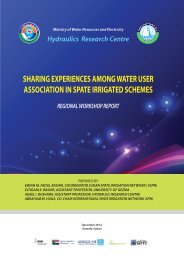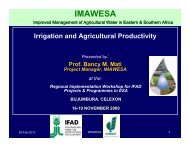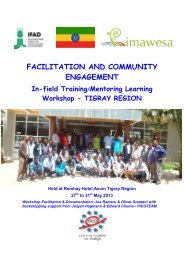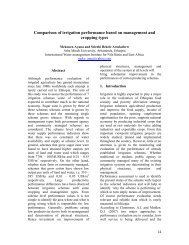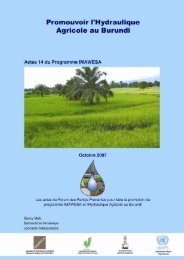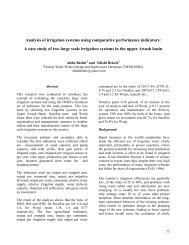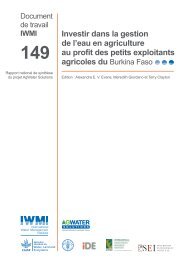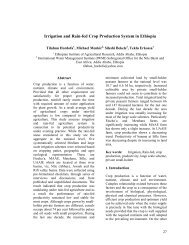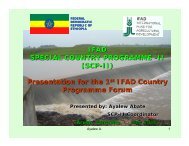Manual - Participatory rapid diagnosis and action ... - FAO.org
Manual - Participatory rapid diagnosis and action ... - FAO.org
Manual - Participatory rapid diagnosis and action ... - FAO.org
You also want an ePaper? Increase the reach of your titles
YUMPU automatically turns print PDFs into web optimized ePapers that Google loves.
PRDA <strong>Manual</strong> 23the irrigated scheme rather than collecting <strong>and</strong> processing quantitative data.The Rapid Diagnosis is also meant to establish a good working relationshipbetween the project <strong>and</strong> the farmers’ <strong>org</strong>anization for future project activities.Thus it should not be perceived as an external investigation to pass judgmenton farmer’s practices but as a collective reasoning to improve them. Sensitiveinformation such as data farmers’ income should be collected only if farmersare not reluctant to give it. Otherwise value added <strong>and</strong> farmers’ income canbe estimated from information collected about “plot use”.The central question to be answered during the Rapid Diagnosis:What are the limiting factors to irrigated agricultural productivity <strong>and</strong>farmers’ interests?Farmers’ interests relate to the objective they assign to irrigation, for example:maximize food production/ha; maximize income/ha; maximize labourproductivity.As this question is too large to tackle at once, the analysis of available datawill be done during a range of sub-questions divided along the lines of theconceptual framework. Note that these constituents do not imply some sortof chronological order for collecting information. Pieces of informationcollected in an interview with a farmer or while visiting the scheme can applyto various constituents. The four constituents of an irrigated agriculturalsystem should be seen as a framework to co-ordinate data collection as itgoes along for facilitating analysis <strong>and</strong> <strong>diagnosis</strong>.Irrigation scheme: Should the analysis of the irrigation scheme tell whetherthere is insufficient or insecure access to water within all plots?This question immediately brings up a “philosophical” question - whatplots belong to a scheme: those envisaged in the design <strong>and</strong> construction;those according to WUA’s objective; or the total potentially irrigable area?Whatever definition is chosen, the analysis can be best answered along thethree horizontal lines between l<strong>and</strong> <strong>and</strong> water sub-constituents.• Site <strong>and</strong> water resourceIs the water resource a limiting factor to irrigating all the comm<strong>and</strong> areayear-round? If yes, what are the causes <strong>and</strong> what solutions have been foundby farmers to alleviate the problem?



